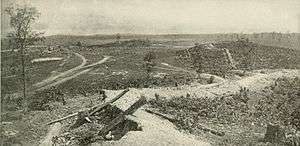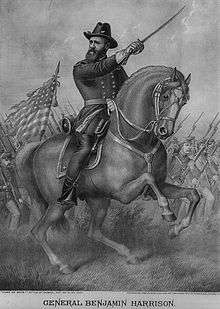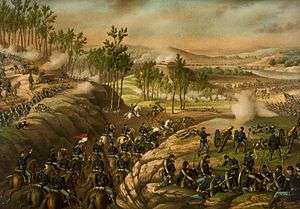Battle of Resaca
| ||||||||||||||||||||||||||||||||||
The Battle of Resaca was part of the Atlanta Campaign of the American Civil War. The battle was waged in both Gordon and Whitfield counties, Georgia, May 13–15, 1864. It ended inconclusively with the Confederate Army retreating. The engagement was fought between the Military Division of the Mississippi (led by Maj. Gen. William T. Sherman) on the side of the Union and the Army of Tennessee (Gen. Joseph E. Johnston) for the Confederates.
Background

In early May 1864, the Confederate government granted Johnston's request for reinforcements to his camps around Dalton, Georgia. As the brigade of Brig. Gen. James Cantey started to move through the city on May 7, 1864, cavalry scouts alerted Johnston that a large number of Union troops were moving towards Rome, Georgia, on roads that led through Resaca. During the remainder of May 7 and the day of May 8 Cantey's brigade had time to entrench and set up defenses.
On May 9, the Army of the Tennessee under the command of James B. McPherson moved out of Snake Creek Gap and immediately ran into a Confederate cavalry brigade ordered to scout the area the day before under the command of Colonel Warren Grigsby. After a fierce battle, Brig. Gen. Thomas W. Sweeny formed a defensive line and drove the Confederates back to Resaca, several miles to the east.
Sherman's plan, as written in his memoirs, was to hold the railroad and telegraph lines south of Dalton so that Johnston would either evacuate his position at Dalton or detach a section of his army to fight Sherman on a ground that had more of an advantage to Sherman. He devoted the Army of the Tennessee for this, while the Army of the Cumberland and the Army of the Ohio, commanded by Maj. Gens. George H. Thomas and John M. Schofield, respectively, would feign attacks in the Confederates's front.
As McPherson's two Corps left the woods, they skirmished with Confederate cavalry for a while until the cavalry was able to withdraw to a line of fortifications on the outer edge of the city, where they were reinforced by the 37th Mississippi, a regiment in James Cantey's brigade.
In the evening, McPherson sent his only cavalry, the 9th Illinois Mounted Infantry, northeast to scout out the best route to the Western & Atlantic Railroad. Meanwhile, skirmishers in Maj. Gen. Grenville M. Dodge's XVI Corps moved to attack a line of fortifications along Camp Creek, held by Confederate cavalry, the remainders of Cantey's Division, two batteries (eight cannons) of Confederate-manufactured 12-pound Napoleon guns and a fresh brigade under Confederate Brig. Gen. Daniel H. Reynolds, which was the lead of the column of 20,000 men sent out from Dalton by Joseph E Johnston.[2]
Battle


Johnston had withdrawn his forces from Rocky Face Ridge to the hills around Resaca.[3] On May 13, the Union troops tested the Confederate lines to pinpoint their whereabouts. The next day full-scale fighting occurred, and the Union troops were generally repulsed except on the Confederate right flank where Sherman did not fully exploit his advantage. On May 15, the battle continued with no advantage to either side until Sherman sent a force across the Oostanaula River, at Lay's Ferry, using newly delivered Cumberland pontoon bridges and advanced towards Johnston's railroad supply line. Unable to halt this Union turning movement, Johnston was forced to retire.
Aftermath
Unable to halt the Union turning movement caused by Sherman's crossing of the Oostanaula, Johnston was forced to retire, burning the railroad span and a nearby wagon bridge in the early morning of May 16.[4] After the Union repaired the bridges and transported more men over, they continued in the pursuit of the Confederates, leading to the Battle of Adairsville on May 17. There were 6,100 combined casualties: 3,500 for the Union and 2,600 for the Confederacy.
Resaca Battlefield State Historic Site
The battlefield is preserved as the Resaca Battlefield State Historic Site.[5]
In popular culture
Ambrose Bierce's short story "Killed at Resaca" focuses on a cohort of men who fight and die bravely at Resaca, and the needless bloodshed of war in general.
See also
Notes
- ↑ http://ngeorgia.com/history/resaca.html
- ↑ William R. Scaife, The Campaign For Atlanta.
- ↑ http://www.historyofwar.org/articles/battles_resaca.html
- ↑ http://darrellryan.homestead.com/Resaca.html
- ↑ Friends of the Resaca Battlefield.
References
- Guernsey, Alfred H.; Alden, Henry M. (May 1866). Harper's Pictoral History of the Civil War. Fairfax Press.
- National Park Service battle description
- Summary about pre-battle period
- Basic summary of battle
Further reading
- Secrist, Philip L. The Battle of Resaca: Atlanta Campaign, 1864. Macon, GA: Mercer University Press, 1998. ISBN 0-86554-601-0.
- Woodworth, Steven E. Nothing but Victory: The Army of the Tennessee, 1861–1865. New York: Alfred A. Knopf, 2005. ISBN 0-375-41218-2.
External links
- Friends of Resaca
- The Battle of Resaca: Maps, histories, photos, and preservation news (Civil War Trust)
- The Civil War in Georgia as told by its Historic Markers - Battle of Resaca
- "Battle of Resaca." New Georgia Encyclopedia.
